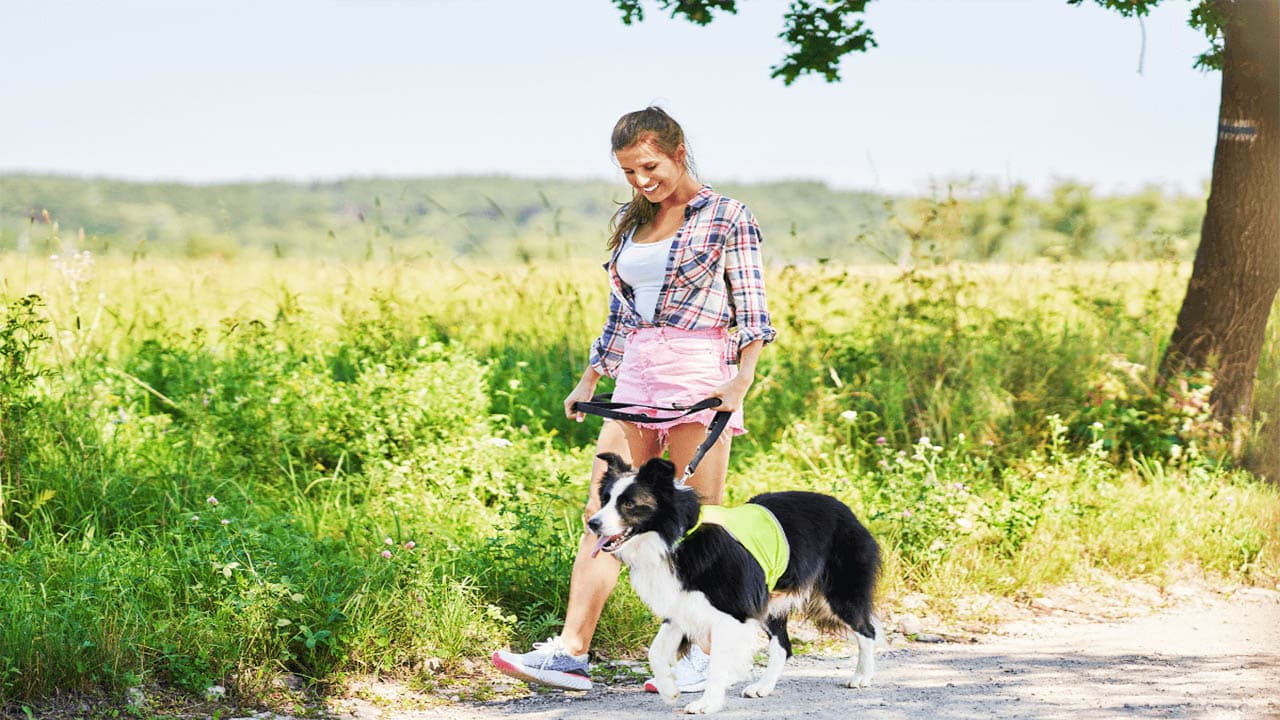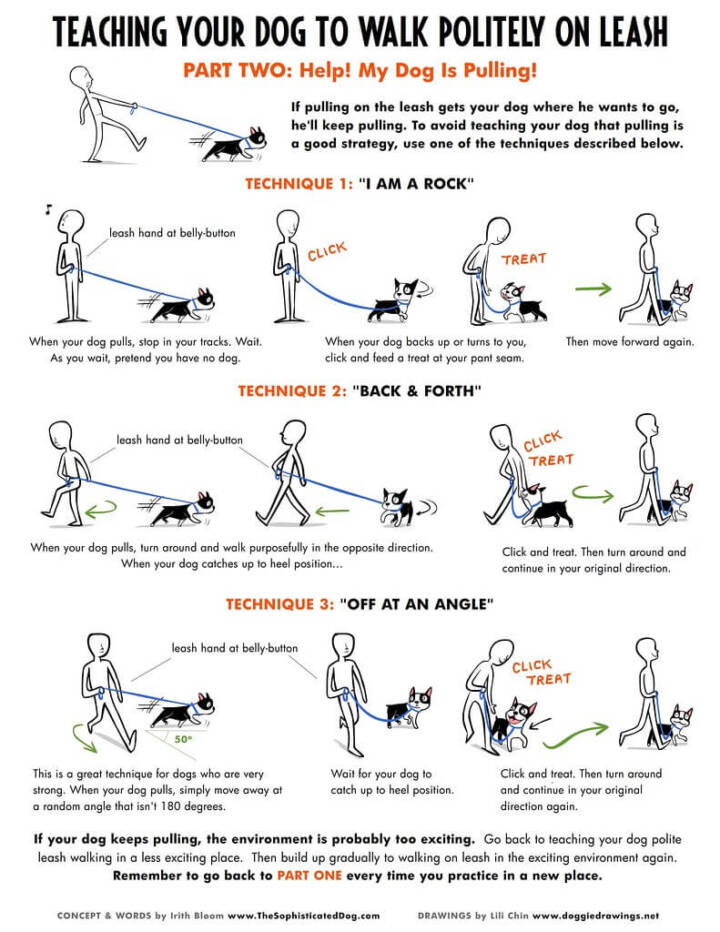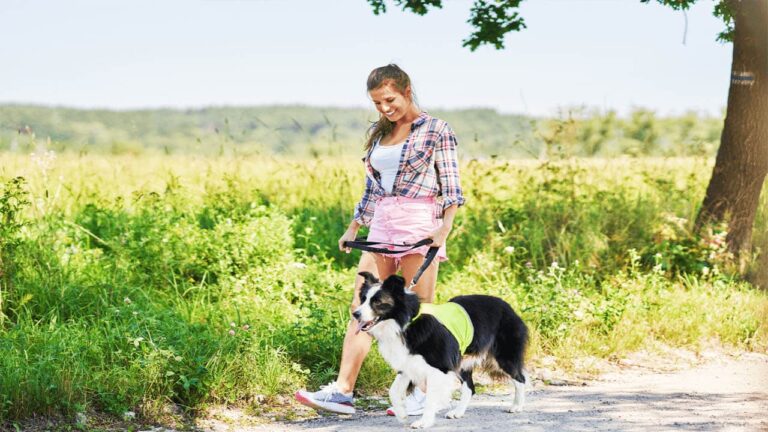To train your dog to walk on a leash, start by choosing a proper leash and collar, then teach your dog to respond to the “heel” command and use positive reinforcement to reward good behavior and discourage bad habits. Consistency and patience are key in ensuring successful leash training for your dog.
Are you struggling with leash training your dog? Walking your dog on a leash can be a challenging task, especially if your furry friend is full of energy and easily distracted. However, with the right approach and techniques, you can effectively train your dog to walk on a leash in a calm and controlled manner.
In this guide, we’ll explore the essential steps and tips to train your dog to walk on a leash, allowing you to enjoy peaceful and enjoyable walks together. Let’s dive into the details of leash training your dog for a more harmonious walking experience.

Choosing The Right Leash
When it comes to training your dog to walk on a leash, one of the first things to consider is choosing the right leash. The leash you choose can have a significant impact on how successful and enjoyable your walks with your furry friend will be.
Material
When selecting a leash material, it’s important to keep in mind both durability and comfort. One of the most common materials for dog leashes is nylon. Nylon leashes are lightweight, affordable, and easy to clean. They are also less likely to cause friction burns if your dog pulls or tugs on the leash. Another option to consider is leather leashes. Leather leashes are durable and can provide a comfortable grip for you. They also become softer and more pliable with use, making them a great choice for long walks. A key consideration when choosing the material is to ensure it is strong enough to withstand your dog’s strength.
Length
The length of the leash is an important factor to consider, as it can affect both your control over your dog and their freedom to explore. A standard leash length is typically around 4 to 6 feet (1.2 to 1.8 meters), which provides a good balance between control and freedom. If you prefer more control, a shorter leash may be suitable. Shorter leashes can help you guide your dog’s movements more easily and keep them closer to you in crowded or high-traffic areas. On the other hand, if you want to give your dog more freedom to roam and explore, a longer leash, such as a retractable leash, can be a suitable choice. Retractable leashes allow you to adjust the length of the leash and give your dog more space to move around.
| Type of Leash | Length | Pros | Cons |
|---|---|---|---|
| Standard Leash | 4 to 6 feet (1.2 to 1.8 meters) | Optimal control and freedom balance | May not provide enough room for exploration |
| Retractable Leash | Variable length | Offers more freedom for your dog to explore | Less control over your dog’s movements |
Choosing the right leash is crucial for successful leash training. Consider the material that is durable, comfortable, and suitable for your dog’s strength. Additionally, think about the length of the leash that strikes a balance between control and freedom. By selecting the perfect leash, you will set yourself and your dog up for enjoyable and effective walks together.

Credit: m.youtube.com
Getting Your Dog Used To The Leash
Introducing your dog to a leash is an essential part of training to ensure safe and controlled walks. Many dogs may initially resist or feel uncomfortable with the leash, so a gradual and positive approach is key to successful leash training.
Introduce The Leash
When introducing the leash to your dog, allow them to investigate it at their own pace. Show the leash to your dog, allowing them to sniff and become familiar with it before attaching it to their collar. This process helps reduce any fear or apprehension about the new object.
Positive Associations
Creating positive associations with the leash is crucial. Use treats or toys to make the leash a source of positivity for your dog. Whenever you bring out the leash, offer a small treat or engage in play to associate it with something enjoyable. Over time, your dog will start to associate the leash with good things and become more receptive to using it.
Teaching Basic Commands
Teaching your dog basic commands is the foundation for a well-behaved walking experience. Ensuring that your dog understands and obeys the commands of sit, stay, and heel will make your walks more enjoyable and safe for both you and your furry friend.
Sit
To teach your dog to sit, follow these steps:
- Hold a treat above your dog’s nose, causing them to lift their head and follow the treat with their nose.
- Move the treat back towards the top of their head while saying “sit.” This will cause your dog to naturally sit down to keep their eyes on the treat.
- As soon as your dog’s bottom touches the ground, give them the treat and offer plenty of praise. Repeat this process several times a day, gradually reducing the use of treats.
Stay
To train your dog to stay, follow these simple steps:
- Start with your dog in a sitting or standing position.
- Hold your hand up, as if signaling “stop,” and while saying “stay,” take a small step back.
- If your dog stays in place for a few seconds, reward them with a treat and praise. Gradually increase the distance and time they must stay before being rewarded.
Heel
Teaching a dog to walk at your side without pulling on the leash is essential for a pleasant walking experience. Here are the steps to teach your dog the heel command:
- Start walking with your dog on a loose leash, then stop and command “heel” while gently guiding them to your preferred side with a treat.
- When your dog reaches the correct position, reward them with a treat and plenty of praise. If they start to pull, stop and wait for them to come back to your side, rewarding them when they do.
- Consistently reinforce the heel command during walks and gradually reduce the use of treats as your dog becomes more familiar with the behavior.
Walking Techniques
When it comes to walking your dog on a leash, it’s important to establish the right techniques. This will not only make the experience more enjoyable for both you and your furry friend, but it will also ensure their safety. Below, we’ll explore three key techniques that will help you train your dog to walk on a leash: starting with short walks, using positive reinforcement, and employing a consistent routine.
Start With Short Walks
When training your dog to walk on a leash, it’s important to start with short walks. This allows your dog to become familiar with the sensation of wearing a leash and gives them a chance to adjust to the new routine. Begin by keeping the walks brief, around 10 to 15 minutes, and gradually increase the duration as your dog becomes more comfortable.
Positive Reinforcement
Positive reinforcement is key to effectively training your dog to walk on a leash. Instead of punishing them for undesirable behavior, such as pulling or lunging, reward them for good behavior. Whenever your dog walks calmly beside you or follows your commands, provide them with treats, praise, or a quick play session. This positive association will motivate them to continue behaving well during walks.
Consistent Routine
Establishing a consistent routine is essential for successfully training your dog to walk on a leash. Dogs thrive on routine, so try to schedule daily walks at the same time and follow a similar route. This will help your dog anticipate and understand the purpose of the walk, making them more focused and responsive to your instructions. Consistency is key to building good walking habits with your dog.
Handling Challenges
Even with the best intentions and training techniques, walking a dog on a leash can present some challenges. In this section, we will discuss how to overcome common issues such as pulling on the leash and distractions.
Pulling On The Leash
One of the most common challenges dog owners face while walking their furry friends is dealing with pulling on the leash. Pulling can make the walk frustrating and even dangerous, as it can lead to injuries or the dog escaping. Here are a few tips to help solve this problem:
- Use a no-pull harness or a head halter: These devices provide more control and can help discourage pulling. (Bold Phrase: “no-pull harness” and “head halter”).
- Practice loose leash walking: Teach your dog to walk politely by your side without tension on the leash. (Bold Phrase: “loose leash walking”).
- Stop and stand still: Whenever your dog starts to pull, stop and wait for them to calm down before continuing the walk. This teaches them that pulling gets them nowhere. (Bold Phrase: “stop and stand still”).
- Redirect their attention: If your dog is pulling towards something exciting, redirect their attention to you by using treats or a favorite toy. (Bold Phrase: “redirect their attention”).
- Consistency is key: Be patient and consistent with your training. It takes time for your dog to learn proper leash manners. (Bold Phrase: “Consistency is key”).
Distractions
Another challenge you may encounter while walking your dog on a leash is distractions. Dogs are naturally curious creatures and can easily get distracted by sights, sounds, and smells. Here’s how you can handle distractions effectively:
- Start training in a low-distraction environment: Begin the training process in a quiet area with fewer distractions, such as your backyard or a quiet park. (Bold Phrase: “low-distraction environment”).
- Gradually increase the level of distractions: Once your dog is comfortable walking without distractions, gradually introduce new distractions, such as other dogs or people walking by. (Bold Phrase: “Increase the level of distractions”).
- Use positive reinforcement: Reward your dog with praise and treats for ignoring distractions and focusing on you. (Bold Phrase: “positive reinforcement”).
- Distract your dog before they become fixated: If you see your dog starting to fixate on a distraction, redirect their attention to something more interesting or give them a command to refocus their attention. (Bold Phrase: “Distract your dog before they become fixated”).
- Practice, practice, practice: The more exposure your dog has to different distractions, the better they will become at ignoring them and staying focused on the walk. (Bold Phrase: “Practice, practice, practice”).

Credit: spcanevada.org
FAQ Of How To Train Walking A Dog On A Leash
How Can I Train My Dog To Walk On A Leash Without Pulling?
To train your dog to walk on a leash without pulling, use positive reinforcement techniques such as rewards and praise when your dog walks calmly by your side. Start with short walks in a quiet area, gradually increasing the duration and difficulty. Consistency and patience are key to success.
When Should I Start Leash Training My Puppy?
It’s best to start leash training your puppy as early as possible, ideally around 8 to 10 weeks old. However, make sure your puppy has had all the necessary vaccinations before going on walks outside. Introduce them to the leash and use positive reinforcement methods to create a positive association with walking on a leash.
How Long Does It Take To Train A Dog To Walk On A Leash?
The time it takes to train a dog to walk on a leash varies depending on the dog’s age, breed, and previous experiences. It can take anywhere from a few days to several months. Consistent training, patience, and positive reinforcement are key to achieving success in leash training.
How Do I Stop My Dog From Pulling On The Leash?
To stop your dog from pulling on the leash, use positive reinforcement techniques. When your dog starts pulling, stop walking and wait for them to relax and come back to your side. Reward them with praise and treats when they walk calmly. Consistency in training and positive reinforcement will help break the pulling habit.
Conclusion
To train a dog to walk on a leash is essential for a safe and enjoyable experience. Remember to start with short sessions, using positive reinforcement to reward good behavior. Consistency is key, as is providing a comfortable and properly fitted leash and collar.
With time and patience, your dog will learn to walk beside you, making walks a pleasure for both of you. So, take the leash, follow these steps, and enjoy the benefits of a well-trained walking companion!



